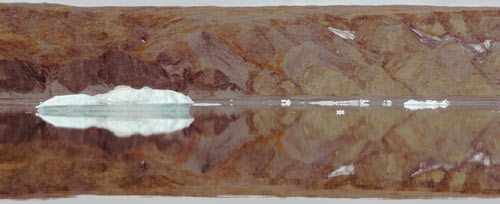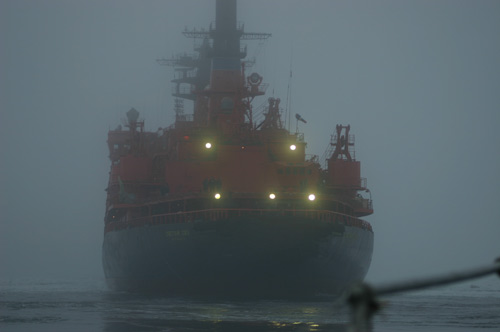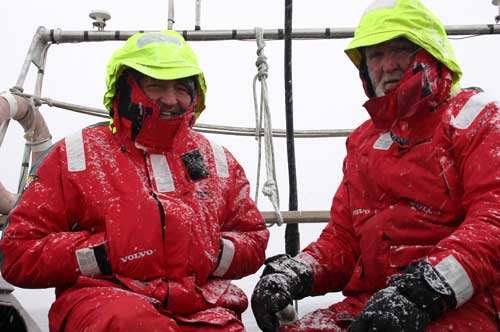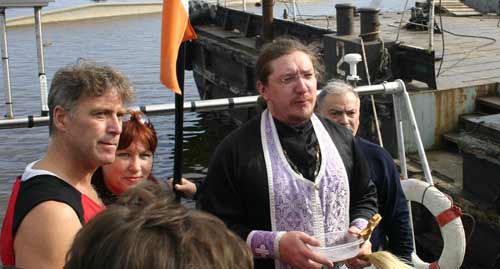Progress report 5
21st August 2005
The Fire Station siren wailed. A ship in the river hooted, as last Thursday morning, we left Khatanga and began our river journey. A half dozen people waved us good-bye.
Well might the hooters toot; we had left a lot of money in Khatanga.
The river flowed at 3 knots, each of its twisting sections marked by transit marks on shore, the shallows and blind channels in wait for the unvigilant. With our borrowed River Pilot chart book we ticked them off.
That night we passed a reindeer swimming and the river ferry 'Taimur', going upriver, old friends. She flashed her lights in salute; we waved our thanks.
Around midnight we passed a native Dolgan village, all in darkness, save one light down at the river bank.
In Fridays early light the river widened and grew shallow as, our 31 sections completed, the 'Zaliv' ( Bay ) spread north-eastwards before us. A brisk wind filled our sails and gave us 7 knots-mighty to be on our way.
All day it blew a fresh force 5 from the north-west. There was going to be ice ahead, but this just might blow it out enough from the shore to let us by.
It continued through the night. There was a little more light than last night , just a dullness for about 3 hours.
South west of Bolshoi Begicheff Ostrov (Island) we met the oil- tanker bringing in the annual supply, several days overdue. She, led by a river ice-breaker, had had a hard slow time breaking through the ice.
By Saturday evening we had made great progress up the barren east coast of the Taimur Peninsula. There was ice, but with only an occasional 'fight' for us through bands about ½ mile wide. Ice is never ( nearly ) so bad when you can see clear water on the other side.
By mid-afternoon we were at latitude 75 degrees 50 minutes, only about 30 miles short of last years 'furthest north', so hard won then.
At 16.00 hours our log reads
"We've just had sat-phone contact with Nicolay Babich ( our Murmansk 'Controller').
Babich says:
"There's heavy ice inshore ahead."
"The Atomic I/B ( Ice-Breaker) 'Sovietskiy Sojuz' is stationed 70 miles from us, offshore." He gave us its lat/long.
Recommends that we should alter course towards it, working as best we can through the ice.
We took his recommendation, but with considerable misgivings.
Much of Northabout's success in getting through ice is due to her shallow draft ( with centreboard up ), which allows us to scrape along, inshore of ice, where bigger vessels can't go.
Going offshore we fought ice all the way. By 22.00 we had come to a full-stop.
We just couldn't make any further progress in what was now 8/10 ice with occasional bands, now none. We were faced with the prospect of sitting tight in the ice, waiting out a change, days indefinite. Or going backwards, if we could, to the sheltered area of Martha Island, where we had spent 11 frustrating days last year.
We chose a third option ! We radioed 'Sovietski Sojuz', 2nd Generation Nuclear.
" Hello Lads, How's it goin'?
Not too bad in the ice-breaker, is that a fact!
Not great for us---- seein' as how you ask.
Any chance of an oul dig out? "
Not a hope, they had never heard of us, had no Instructions.
Well, we sat-phoned Murmansk, got hold of Mr. Babich ( not bad for a Saturday night), and our Slava turned on the charm, and how.
Over the next hour the communication was hot. Tension filled our cabin .
Outside, the ice filled in around us in a light fog. Silence.
Then , midnight, came the word. The I/B would be on its way, at 18 knots, through the ice---what a machine!
At 3am this morning it broke through, did a wheelie, big wheelie, the water churned around us, house sized ice lumps jumping around us-what had we brought on ourselves?, more than we could chew??
VHF radios rat-tat-tatted, her wash streamed back around us, her beam jets blew and the ice cleared-a clear channel, about 40 metres wide.
And off we went, at 7 knots through the solid field of broken, densely packed grey. Some gulls and a harassing skua appeared, fishing in the churned water.
Our sounder showed only about 3 metres, even though we knew it to be 50 metres deep---the cavitation from the big ships propellers was doing that. Her stern lights, 70 metres ahead, burned through the thickened fog. Our engine didn't falter.
At 07.30 this Sunday morning we were out of the ice, into the open calm Laptev Sea. She hove to, we went alongside, diminutive, exchanged greetings and bagged presents, sent down and up on lines and we were on our way.
It snowed earlier. Now, it's 1pm, the air is minus two degrees, and we're moving fast and hard along the Saint Nichola Sea-Route, 295 degrees, towards Proliv Vilkitsgi.
Cape Chelyuskin, Cape Horn of the North, is only 110 miles away.
The Tundra Coast

The Stern Lights of the Icebreaker

Rory and Jarlath on Watch

Blessing of the Boat in Kathanga
